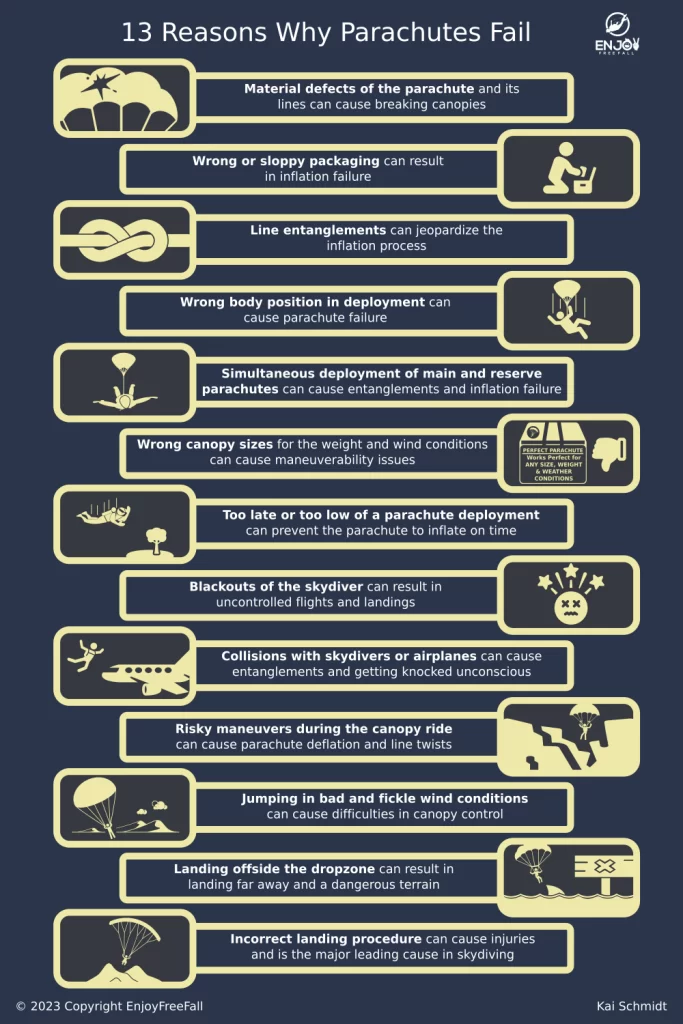
Skydiving is a highly regulated sport that becomes safer and safer. However, we still hear of skydiving accidents from time to time so the question arises why do parachutes still fail?
Parachutes can fail when their canopies have holes, their permissible total weight is exceeded or lines are rubbed off. However, most of skydiving accidents do not happen due to parachute failure or material defects but due to human error.
The likelihood that someone experiences a parachute failure is extremely low – if not close to zero. If the first parachute does not work, skydivers are still equipped with a reserve parachute. The likelihood that both parachutes fail due to material defects is 0.000017%.
However, skydiving accidents still happen mostly because of human error and because of one of the following 13 causes:
- Material defects of the parachute and its lines can cause breaking canopies
- Wrong or sloppy packaging results in inflation failure
- Line entanglements jeopardize the inflation process
- Skydivers have the wrong body position when they deploy the parachute
- Early deployment of the reserve parachute
- Picking the wrong canopy size for the weight and wind conditions
- Deploying the parachute too late/ too low
- Blackouts of the skydiver result in no pull
- Collisions with other skydivers or airplanes
- Risky canopy maneuvers during the canopy ride
- Jumping in unfavorable and unpredictable wind conditions
- Landing offside the dropzone
- Executing the landing procedure incorrectly
Material Defects Of The Parachute And Its Lines
As mentioned in the introduction, material defects are extremely rare and the likelihood that it happens is practically 0%. Skydiving equipment manufacturers make canopies, lines, and harnesses out of special fabrics that are extremely robust and durable. As a result, they are extremely reliable and safe. In addition, skydiving companies regularly check their equipment for any defects in order to make sure that they do not have any holes in it.
If the canopy has any holes or parts that are rubbed off it can break during the inflation process. The holes can also increase in size due to the air that is pressed through the hole. In the very best case, the canopy will still carry the weight of the skydiver and will just be much harder to steer. In the more likely scenario, it will not carry the weight of the skydiver and the skydiver will fall downwards towards the earth unbraked.
It can also happen that one of the lines breaks because it has been ripped off and used for a long-time. In this case, the canopy will not be held horizontally to the earth such that the air does not pile up under the canopy. As a result, the canopy does not inflate and the skydiver should cut it loose and deploy his reserve parachute.
Wrong And Sloppy Packaging Pose A Great Safety Risk For Skydivers
Incorrect packaging is one of the greatest causes of inflation problems of the canopy during freefall. It often happens if people pack their parachutes with haste or while being distracted by other things. As a beginner, you cannot imagine how someone would not pay attention to proper packaging, however, after you have performed hundreds of jumps you will not care as much (even though you should).
Wrong packaging can often slow the inflation process of the parachute down because it might not lay in the right position. Line entanglements between the parachute and the robes are also often the result of sloppy packaging.
In order to reduce accidents followed by sloppy packaging, regulators have introduced the rule that reserve parachutes cannot be packed by normal skydivers. Every reserve parachute is by a certified parachute rigger who has undergone special training to make sure that the reserve parachutes are packed properly and will inflate once they are opened.
If you go on a tandem skydive, there is also no need to worry. The tandem instructors are very experienced skydivers who will pack the main parachute properly. They also take special care because they do not jump alone and it’s much more difficult to resolve any problems when you have someone hanging below you – so the best case is always to avoid such problems.
If you are interested in understanding in detail how tandem skydiving works, check out my article about it. It is ideal for skydiving newcomers who will conduct their first jump soon. It covers all safety aspects and provides practical tips to make your jump as enjoyable and memorable as possible!
The skydiving market is also highly competitive with many skydiving companies that fight for customers. Even though a failure of the main parachute is not likely to result in a deadly accident on a tandem skydive because you deploy at a higher altitude than a solo skydive and therefore have more time to open the reserve parachute, it is still an unpleasant experience for novices. And this will cast a bad reputation on the skydiving company.

Line Entanglements Jeopardize The Inflation Process Of Parachutes During A Skydive
Line entanglements are not only the result of sloppy packaging but can be the result of deployment before reaching the necessary speed or the right body position. There are different forms of line entanglements such as pilot chute in tow, slider hang, line twist, or line over. If you want to know about them, there are great Youtube videos out there that explain each malfunction in detail (and with pictures).
One line entanglement problem that I quickly want to touch upon is the line entanglement with the body. It often happens when skydivers open the parachute before they are in the belly-to-earth position.
For example, if the skydiver looks up and faces the earth with his back upon deployment, the parachute will have to pass his body. During this process, the parachutes can be entangled with the body of the skydiver, in which case it fails to open.
Wrong Body Position During Deployment When Skydiving
The worst case of a wrong body position is that the parachute fails to open. However, even if it does open, it will often be an extremely unpleasant experience for the skydiver and can result in severe injuries.
During the inflation process, the parachute already starts to slow the falling speed of the skydiver down. As it opens quite quickly the major break nonetheless happens once the parachute is fully inflated. The parachute is connected to the skydiver through the harness around the legs and back. The harness is designed in such a way that skydivers will be pulled in an upward position so that they can sit during the canopy ride.
It will be quite unpleasant to pull in this position from a head-down or back-facing-earth position. Not only does it hurt, but it can also cause muscle injuries around your neck and back. Skydivers are also likely to lose their orientation in this process which can result in collisions with other skydivers.
Wrong body positions during deployment often happen if skydivers open their parachute unintentionally. While this happens more to beginners it can also happen to experts. Unintentional openings can also be very risky because other skydivers will not anticipate the deployment and might be so close that they collide.
Are you curious about how likely you will get injured during a skydive? Check out my article about the true risks of skydiving. It will give you a mind-blowing, new perspective on the sport!
Simultaneous Deployment Of Main And Reserve Parachute Can Have Two Separate Risks
Although it is not an extremely common source of accidents it happens sometimes that people pull the main and the reserve parachute at the same time. The two parachutes might get entangled and fail to open properly.
As a result, the skydiver will not be decelerated and will continue falling at terminal velocity towards the earth. In those cases, skydivers should try to cut the main parachute loose and hope that the entanglement is resolved.
It can also happen that both “canopies are out”. In these cases, both parachutes will inflate and decelerate the speed drastically. The problem in this scenario is that it is quite impossible to steer both parachutes. As a result, you have no control over where you go anymore and the landing maneuver will be much more difficult. In this case, it is also advisable to cut the main parachute loose.
Picking The Wrong Canopy Size Can Be Fatal When Skydiving
Canopies are usually picked in accordance with the weight of the skydiver and the rest of the equipment. Every canopy comes with a weight limit on how much it can carry. The biggest parachutes are usually tandem parachutes that are capable of carrying up to 500 pounds (227 kg). This limit includes the weight of the student, the tandem instructor, and the weight of the parachute systems.
Picking a parachute that is too small means that the parachute will not slow the falling speed down enough – something that can result in injuries during the landing or even death. On the contrary, picking a canopy that is too big often makes it harder to steer the canopy and to arrive at the desired destination.
As a result, there are weight limits in place on how much students can weigh during tandem skydives. If you are concerned about the weight limit, I have summarized the most important points in this article including three ways to jump even if you exceed the weight limits.
Deploying The Parachute Too Late Or Too Low Has Mostly Been Resolved
The recommended height for people depends on their skill level and ranges from 2,500 – 4,000ft (760 – 1,220m). Professional skydivers can pull their parachute as low as 1,200ft. Theoretically, skydivers could pull their parachutes as low as 600-700ft and still survive the fall. Anything below that height will most certainly result in death.
Practically, skydivers would never try to open the parachute lower than 1,200ft because they would not have enough time to deal with any problem that might occur. They would need to cut the main parachute off so that the reserve parachute has enough time to inflate and bring their speed down.
If you want to know how much reaction time skydivers have to resolve issues during the parachute deployment process, feel free to refer to my guide on when to pull the parachute. It also includes tips and tricks to ensure a safe parachute deployment.
Low pulls have been drastically reduced by the introduction of automatic deployment systems that deploy at a preset altitude. It is one of the best examples of the progress that sport makes and that it becomes even safer than it already is.
Blackouts Of The Skydiver Result In Uncontrolled Flights And Landings
Blackouts of the skydiver mean that the skydiver becomes unconscious during the skydive or is paralyzed by fear. As a result, he will not be able to move or deploy the parachute. While the automatic deployment systems have decreased the deadly consequences of blackouts drastically, it is still dangerous.
When being unconscious or paralyzed, the skydiver will fall through the air uncontrolled. Even if the parachute does open properly, the skydiver will be pushed around by the inf and will land offside the dropzone. It is also very likely that the skydiver will get injured during the landing.
Additionally, not everyone wears an automatic deployment device. In this case, they rely on other skydivers to rescue them. Below you can find an incredible video where a skydiver has a seizure and another skydiver tried to deploy his parachute.
Collision With Other Skydivers Or Airplanes
Specifically, when many people jump at the same time e.g. during formation jumps, they might collide during the freefall or after they have deployed their canopies. This can result in an entanglement between their parachutes which leaves them unable to fly.
It can also happen that one skydiver is knocked unconscious during the collision so that he cannot follow emergency procedures and deploy his back-up parachute. Collisions are also often the result of an unintentional early parachute deployment while other skydivers are still close.
In order to mitigate these risks, skydivers usually predetermine a jumping order. During formation jumps, skydivers will also have an order who deploys the parachute first and in which direction everyone tracks away.
Risky Canopy Manoeuvres During The Canopy Rides Are Often Caused By Overconfidence
Some skydivers might become a little bit too overconfident in their abilities after performing many jumps. While it is normal to play around with the canopy and try to do different maneuvers, skydivers should be able to assess their own abilities. Advancing too fast and doing maneuvers above one’s skill level can cause the parachute to deflate or lines to entangle.
If that happens, skydivers do not always have the time to resolve it or to deploy their reserve parachute. In general, risky canopy maneuvers are more likely than a material defect – and also something that could easily be avoided.
If you are interested in knowing more about skydiving maneuvers, here is a great article from another skydiving blog about different exercises to become a better canopy pilot.
Unfavorable Weather Conditions Should Be Avoided When Skydiving
Skydivers usually only jump when the weather conditions are stable and the wind is not too strong. However, it can happen that the forecast suddenly changes and skydivers get on the plane and jump nonetheless. This is not only much more common than a material defect of the parachute but also much easier to avoid.
The problem with changing forecasts is that skydivers might not have picked the right canopy size for their jump and that they are not properly prepared for the jump. When the find suddenly changes or picks up, it is much harder to steer the canopy. If it suddenly gets cloudy, it is also more difficult to orientate and to find the way back to the dropzone.
Landing Offside Of The Dropzone Is Annoying If Not Fatal For Skydivers
Landing offside the dropzone is often a result of poor judgment and steering mistakes during the canopy ride. It is also far more likely and dangerous than material defects. If a material defect happens and the main parachute fails, the skydiver still has the reserve parachute that will bring him down safely.
However, landing offside the dropzone means that the skydiver lands in terrain that he does not know. In the worst-case scenario, he will hit objects such as barbed wire, stones, or electric fences. In the best case, he lands close to the dropzone and can walk back.
Although it does not have deadly consequences, landing far away from the dropzone is also a real pain for the skydiver and mates. He will need to organize a ride back to the dropzone without knowing where he is and his friends will start to worry about him.
Skydivers often also do not bring their smartphones with them on a jump, which leaves them without communication devices.
Executing The Landing Procedure Incorrectly Is The Biggest Cause Of Skydiving Accidents
Landing mistakes are the most common source of skydiving injuries (not fatalities). Specifically, in the beginning, it is challenging to have the right speed and angle upon landing. Novice skydivers are also not used to retaining the impact with their body as well as experienced skydivers are.
Regular stretching and training of the leg and butt muscles help to become safer during landings. While the muscles will adjust quite quickly to the new burden, the tendons, ligaments, and joints need approximately two years to adjust.
As a result, novice skydivers should try to be as slow as possible during a landing to avoid unnecessary injuries. Using larger canopies also helps to achieve softer landings.
As there is very little room for error during the landing process, I wrote an article about the essentials you need to learn to ensure your safe landing. Make sure to read it before your next skydive!
The Risks Of Jumping Tandem
Tandem jumps are in general much safer than solo jumps because people jump with an experienced tandem instructor. Tandem instructors have often performed thousands of jumps before and have undergone special safety training before getting their license.
Almost all of the aforementioned causes of skydiving accidents are less likely to happen to tandem instructors. And if something happens, they are experienced enough to resolve it in time.
If you are interested in knowing more about the reasons why tandem skydiving is 2.5 times safer than solo skydiving, you can refer to this article.
In conclusion, material defects are the least likely cause of skydiving accidents and you should not worry about them.
That being said, I hope that you go skydiving soon.
Enjoy your freefall!



